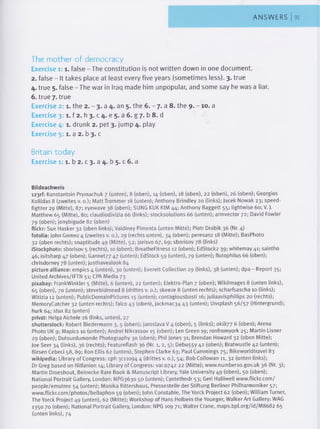This document provides an overview of Britain and its regions. It begins with an introduction to Great Britain and its constituent countries - England, Wales, Scotland, and Northern Ireland. It then provides 3 sentences or less summaries of sections on London, England, and the north-south divide in England.
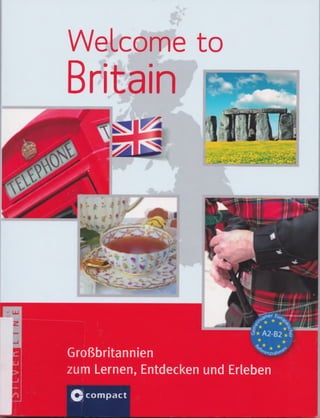






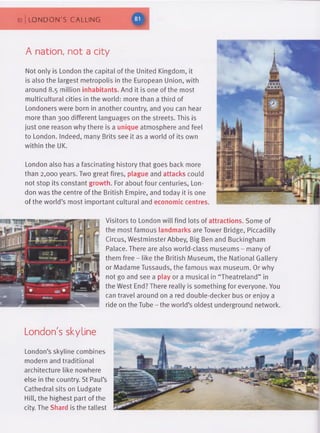







![18 THE WELSH DRAGON
Druids and dragons
According to stories from long ago, Wales was once home
to Druids and Celtic poets known as bards. These Celts were
in fact the Britons who lived all over the island before Roman
and Saxon invaders pushed them to the west. The legendary
King Arthur is their most famous leader, and the red dragon
as a symbol for Wales goes back to a story about him.
Capital:
Cardiff
Population: 3.1 million
Patron Saint: St David
National flower: daffodil
Sheep and castles
There are a lot of high hills and deep
valleys in Wales, and the ground in many
areas is poor for growing vegetables.
However, it is perfect for sheep! In fact,
there are about three sheep for every
person in Wales. The green hills are
also home to more than 600 castles -
more per square kilometre than any
other country in the world.
The Welsh word for Wales is "Cymru" PkAmri], which means "land of fellow
countrymen". The original meaning of the English word "Welsh" is "foreign" or
"not Anglo-Saxon". These are two very different definitions for the same nation!
Cardiff
Wales is a peaceful and green country. Only
three of its cities have a population of more
than 100,000 people, and all of these are on
the south coast. Cardiff, the capital, is easy
to visit on foot. Highlights for visitors include
the National Museum, Cardiff Castle, Cardiff
Bay and the extraordinary Millennium
Stadium, which opened in 1999. Cardiff is](https://image.slidesharecdn.com/welcometobritain-astlyo-220514152101-4f85783e/85/welcome_to_britain_-_astly_o-pdf-16-320.jpg)
![THE WELSH DRAGON ■
;
also home to the Senedd, which houses the National Assembly of Wales. It was
created after the people of Wales decided in 1997 that they wanted their own
government for certain issues.
A bilingual culture
There are two official languages in Wales: English and Welsh, a Celtic language. Every
body speaks English and around half a million people are fluent in Welsh. All children
have to learn Welsh at school until they are 16, and there are TV and radio programmes
in Welsh. Road signs and place names are in both languages, though trying to pro
nounce them will certainly be a challenge for most visitors! For example, could you
ask for a ticket to this railway station, which has the longest name in the world?
IIIU IA ll1
»Ik'h ^ ^ w w 3;yw ■ i i£1»j;i*j1
1
vib< , JH'Jt'llfitj1
! I*!cttlef>f
Llan-vire-pooll-guin-gili-go-ger-u-queern-drob-ooll-llandus-ilio-gogo-goch .
Holyhead
A creative nation
Music and poetry have a special place in Welsh culture. In addition to world-famous
singers of pop and classical music, such as Sir Tom Jones and Bryn Terfel, Wales is
famous for its male voice choirs. The eisteddfod [ai'steövod] is a popular type of
festival that celebrates Welsh poetry, music and dance.
invader
daffodil
square kilometre
fellow country
men pi
Eindringling
Narzisse
Quadratkilometer
Landsleute
national assembly
issue
to be fluent in...
challenge
male voice choir
Nationalversammlung
Thema
... fließend sprechen
Herausforderung
Männerchor](https://image.slidesharecdn.com/welcometobritain-astlyo-220514152101-4f85783e/85/welcome_to_britain_-_astly_o-pdf-17-320.jpg)




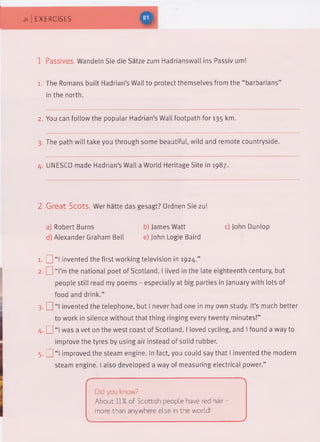

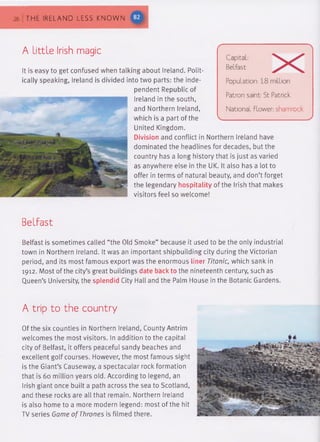









![1 Mind your Language! Für viele alltägliche Begriffe gibt es eine sogenannte „U“
(upper class) und eine „non-U“ (not upper-class) Variante, die man verwendet,
um „posher“ zu klingen. Ordnen Sie zu!
U expression non-U expression
1. 0 napkin a) perfume
2. □ jam b) serviette
3. n lavatory c) dentures
4. □ sofa d) toilet
5. D scent e) settee
6. n false teeth f) preserve
2 Famous Brits. Welche berühmten Briten werden beschrieben? Ordnen Sie zu!
a) This singer and musician from Newcastle upon Tyne is the son of a milkman.
b) This supermodel is the daughter of a Jamaican-born dancer and single mum.
c) This footballer and fashion icon is the son of a hairdresser and a kitchen fitter.
d) This politician and British Prime Minister is the son of a London stockbroker and
had an elite education at Eton and Oxford.
e) This actor is the grandson of a London mayor and was educated at Eton College.
f) This soul singer was raised in London and Brighton by a single mum who works
as a furniture-maker.
2. G Damian
Lewis
4. □ Sting
l. n Adele 3. G David
Cameron
6. []] David
Beckham
5. n Naomi
Campbell](https://image.slidesharecdn.com/welcometobritain-astlyo-220514152101-4f85783e/85/welcome_to_britain_-_astly_o-pdf-34-320.jpg)

















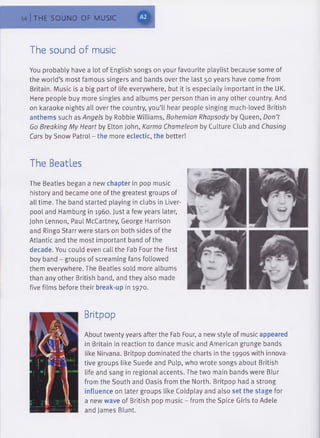






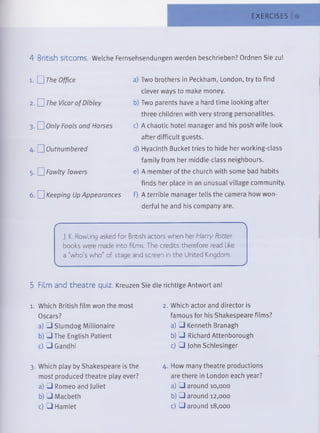

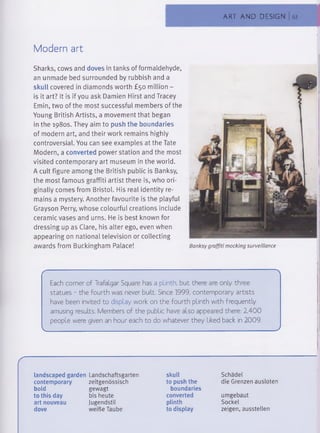

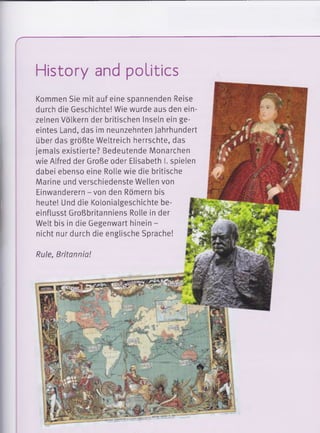
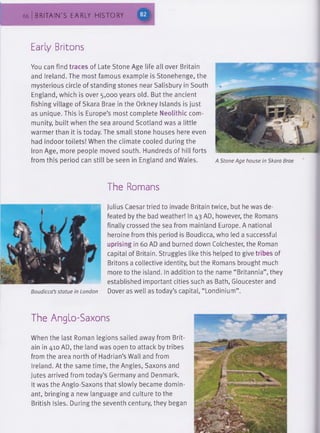

















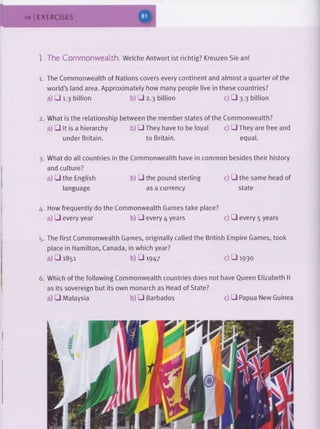


![ANSWERS
Meet the royals
Exercise i: 1. false - They are British, although some of their
ancestors were foreign. 2. true 3. true 4. true 5. false - About
three-quarters of Brits support the monarchy. 6. true 7. true
Exercise 2 :1. Sandringham House 2. The Palace of Holyrood-
house 3. Windsor Castle 4. The Tower of London 5. Buckingham
Palace 6. Balmoral Castle
Exercise 3 :1. are 2. already 3. redesigned 4. its own
5. some of
Exercise 4: 77] pp~
Show some class!
Exercise 1 : 1. b 2. f 3. d 4. e 5. a 6. c
Exercise 2 :1. f 2. e 3. d 4. a 5. b 6. c
Exercise 3 :1. The word “snob” has been adopted by almost every European language.
2. Geoffrey is teased (by them) about eating fast food.
3. He is judged (by people) because of his strong Liverpool accent.
4. Social status is defined by family background, education and accent.
5. An old banger was parked in my mother’s front garden by some chavs.
6. The palace and its land are being bought by a business tycoon.
Exercise 4: 1.
class system 2. aristocrats 3. celebrities 4. toffs 5. snob 6. chavs
7. stereotype](https://image.slidesharecdn.com/welcometobritain-astlyo-220514152101-4f85783e/85/welcome_to_britain_-_astly_o-pdf-85-320.jpg)



